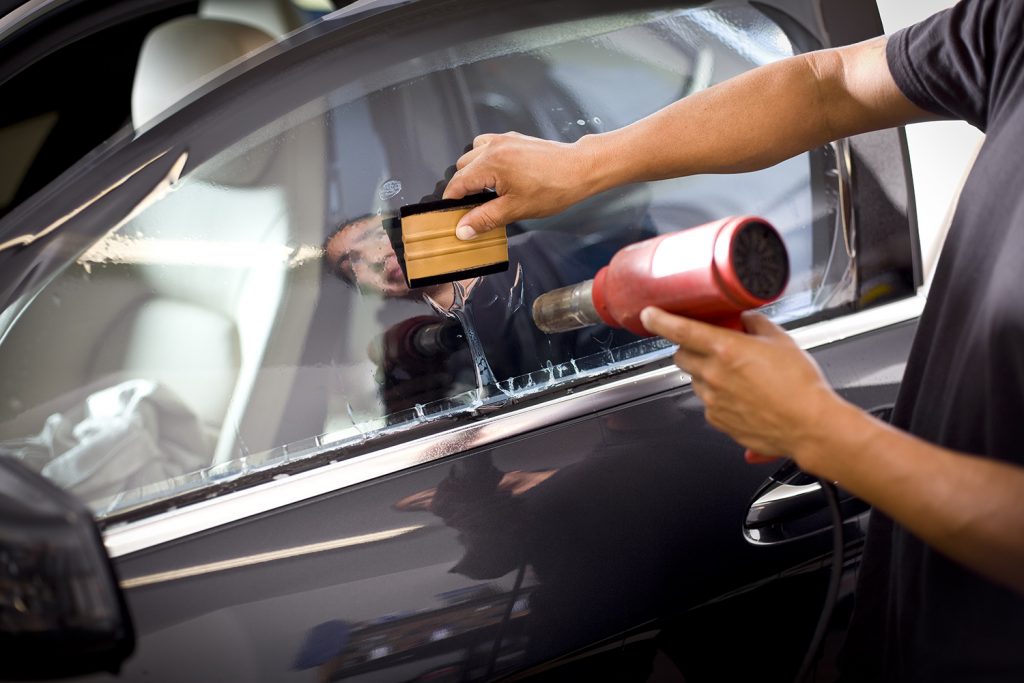How Window Tinting Can Boost Your Automobile's Privacy and Design
How Window Tinting Can Boost Your Automobile's Privacy and Design
Blog Article
The Process of Specialist Home Window Tinting Explained
Recognizing the procedure of professional home window tinting calls for an admiration for the complexities involved in ensuring both aesthetic allure and functional excellence. From selecting the right movie type to the precise preparation of windows, each step plays a crucial duty in attaining a flawless application. Complying with these first prep work, the cautious cutting and application of the film need precision to prevent blemishes. The last assessment and assistance on upkeep stay paramount for lasting fulfillment. What factors contribute to the overall performance of the tinting process, and how can they influence both appearances and performance?
Selecting the Right Window Film
The preliminary factor to consider is the kind of movie, which can vary from colored, metalized, to ceramic films (window tinting). Dyed movies mainly give privacy and aesthetic improvement, while metalized films mirror warm and UV rays, improving power efficiency.
Next, consider the film's Visible Light Transmission (VLT) portion, which figures out just how much light goes into the area. A reduced VLT provides greater personal privacy and warmth denial yet might minimize all-natural light substantially. Additionally, the movie's solar heat gain coefficient (SHGC) is crucial; a lower SHGC indicates far better thermal performance, helping to keep indoor comfort.

Preparing the Windows
As soon as the appropriate window film has been selected, the next action is completely preparing the home windows for installment. This prep work is crucial for attaining optimum attachment and making certain a remarkable appearance post-installation.
The initial job involves cleansing the windows carefully (window tinting). A high-quality glass cleaner is crucial, ideally one that is ammonia-free to avoid damaging any type of home window seals or tint materials. Utilizing a lint-free fabric or paper towels, professionals must get rid of any type of dirt, dirt, or grease, paying unique focus to the sides and corners where particles typically gathers

Cutting the Movie
An exact strategy to reducing the movie is important for ensuring a perfect fit on the prepared windows. This action requires both ability and focus to detail, as mistakes can cause unpleasant voids or overlaps that concession the aesthetic and functional high qualities of the color.
Prior to cutting, the specialist ought to gauge the window measurements properly, making up any kind of one-of-a-kind shapes or shapes. It is suggested to make use of top notch home window movie, as this product often tends to be extra flexible during the cutting process. The film is typically laid level on a tidy, smooth surface area, and a sharp energy knife is employed to ensure clean sides.
To attain optimum outcomes, many experts utilize templates produced from previous installments or utilize software to create specific patterns. An usual method entails adding an additional margin to the layout, enabling for changes throughout the application stage.
In addition, cutting the film in a regulated setting minimizes the risk of contaminants influencing the glue side. By adhering to these meticulous techniques, home window tinting specialists can make sure that the film not just fits flawlessly but also performs efficiently with time, improving both appearance and functionality.
Using the Color
After carefully reducing the movie to the appropriate measurements, the following action involves applying the tint to the window surface. This procedure starts with making certain that the window is tidy and devoid of any dust, debris, or residues that can influence adhesion. A customized cleaning option is commonly used, adhered to by comprehensive drying with a lint-free fabric.
When the surface is prepared, the installer will very carefully place the tint film versus the glass. It is imperative to straighten the film precisely to stay clear of misplacement, as any mistakes can result in a less than professional appearance. To facilitate this, the installer might make use of a light mist of application solution on the glue side of the film, permitting minor repositioning if essential.
Utilizing a squeegee, the installer will then start to push the movie onto the glass, working from the facility outwards to get more information rid of air bubbles and guarantee web a firm bond. This technique is important, as it assures a smooth and remarkable surface. Throughout the application, focus to information is crucial to stop creases or flaws, ensuring that the color not only improves aesthetic appeals however additionally supplies the preferred capability.
Last Inspection and Treatment
The final assessment is a crucial action in the home window tinting procedure, guaranteeing that the installation satisfies both aesthetic and functional standards. During this stage, experts thoroughly check out the mounted color for any kind of flaws, such as bubbles, folds, or misalignments. An extensive assessment also includes inspecting the adherence of the movie to the glass, in addition to its harmony and overall appearance.
After the evaluation, appropriate care and upkeep guidelines are supplied to the customer. It is essential to notify them regarding the suggested timeline for cleaning the tinted windows, typically recommending a wait of at the very least one month after installment to allow the adhesive to cure totally. Clients need to be enlightened on ideal cleaning items and methods, highlighting the evasion of ammonia-based cleansers that can harm the tint.
Furthermore, specialists must recommend clients on the value of normal maintenance to lengthen the life of the color. This includes periodic checks for indicators of wear or damages and reacting promptly to any kind of issues. By ensuring a comprehensive last inspection and supplying clear care guidelines, home window tinting specialists enhance customer complete satisfaction and the long life of their work.
Conclusion
The professional window tinting process incorporates several essential steps that make certain high-quality outcomes. Picking the ideal movie kind, preparing the windows thoroughly, accurately cutting the movie, and applying it with precision are essential for achieving a perfect surface. A comprehensive last you can find out more assessment warranties that all standards are satisfied, while proper post-installation care is essential for keeping the tint's durability and performance. Following these procedures inevitably improves both the aesthetic allure and performance of the tinted home windows.
Report this page